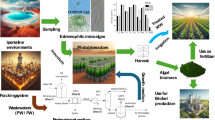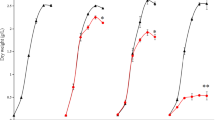Abstract
Hydrothermal gasification is a process which uses any biomass or carbon-containing source as substrate to generate biogas of regenerative energy production. We used microalgae as biomass source and evaluated the potential of using the residual water of the conversion process as recycled nutrient source for cultivation of microalgae. Nutrient recycling was tested by monitoring growth of Acutodesmus obliquus and Chlorella vulgaris on residual water from hydrothermal gasification of A. obliquus. Four different gasification set ups were tested. After the procedure, all obtained liquid nutrient phases contained, beside nutrients, growth-inhibiting substances affecting photosynthetic activity and biomass yield of the two algal species. At least 28 potential toxic substances were found within one of the batches. Phytotoxicity on cellular structure was verified by electron microscopy. The cell form remained intact but cell compartments vanished. C. vulgaris was not able to recover to a vital growing organism during cultivation, whereas A. obliquus was able to restore cell compartments, photosynthetic activity and growth after 3 days of cultivation. A 355-fold dilution, UV treatment for 4 h and activated carbon filtration of the residual water from gasification finally enabled the discharge to support microalgal growth. UV treatment eliminated 23 substances but generated 4 new substances that were not detected before treatment. Activated carbon filtration eliminated 26 substances. Growth of microalgae obtained in the treated residual water was comparable with that in control medium. This study demonstrated the possibility to recover nutrients after the hydrothermal gasification process when the discharge got remediated to restart the value adding chain of microalgae and lower additional nutrient supply for microalgal cultivation.









Similar content being viewed by others
References
Aro EM, Virgin I, Andersson B (1993) Photoinhibition of photosystem II. Inactivation, protein damage and turnover. BBA-Bioenerg 1143:113–134
Ashley K, Cordell D, Mavinic D (2011) A brief history of phosphorus: from the philosopher’s stone to nutrient recovery and reuse. Chemosphere 84:737–746
Bernstein MP, Sandford SA, Allamandola LJ, Gillette JS, Clemett SJ, Zare RN (1999) UV irradiation of polycyclic aromatic hydrocarbons in ices: production of alcohols, quinones, and ethers. Science 283:1135–1138
Biller P, Ross AB, Skill SC, Lea-Langton A, Balasundaram B, Hall C, Riley R, Llewellyn CA (2012) Nutrient recycling of aqueous phase for microalgae cultivation from the hydrothermal liquefaction process. Algal Res 1:70–76
Boukis N, Galla U, D’Jesus P, Müller H, Dinjus E, (2005) Gasification of wet biomass in supercritical water. Results of pilot plant experiments. In: 14th European Biomass Conference, Paris. pp 964–967
Brown TM, Duan P, Savage PE (2010) Hydrothermal liquefaction and gasification of Nannochloropsis sp. Energ Fuel 24:3639–3646
Burlew JS (ed) (1953) Algal culture. From laboratory to pilot plant. Carnegie Institution, Washington
Chakinala AG, Brilman DW, van Swaaij WP, Kersten SR (2009) Catalytic and non-catalytic supercritical water gasification of microalgae and glycerol. Ind Eng Chem Res 49:1113–1122
Converti A, Casazza AA, Ortiz EY, Perego P, Del Borghi M (2009) Effect of temperature and nitrogen concentration on the growth and lipid content of Nannochloropsis oculata and Chlorella vulgaris for biodiesel production. Chem Eng Process Process Intensif 48:1146–1151
Du Z, Hu B, Shi A, Ma X, Cheng Y, Chen P, Liu Y, Lin X, Ruan R (2012) Cultivation of a microalga Chlorella vulgaris using recycled aqueous phase nutrients from hydrothermal carbonization process. Bioresour Technol 126:354–357
Fuerst EP, Norman MA (1991) Interactions of herbicides with photosynthetic electron transport. Weed Sci 39:458–464
Galloway JN, Townsend AR, Erisman JW, Bekunda M, Cai Z, Freney JR, Martinelli LA, Seitzinger SP, Sutton MA (2008) Transformation of the nitrogen cycle: recent trends, questions, and potential solutions. Science 320:889–892
Garcia Alba L, Torri C, Fabbri D, Kersten SR, Brilman DW (2013) Microalgae growth on the aqueous phase from hydrothermal liquefaction of the same microalgae. Chem Eng J 228:214–223
Genty B, Briantais JM, Baker NR (1989) The relationship between the quantum yield of photosynthetic electron transport and quenching of chlorophyll fluorescence. BBA-Gen Subj 990:87–92
Hanelt D, Nultsch W (1995) Field studies of photoinhibition show non-correlations between oxygen and fluorescence measurements in the arctic red alga Palmaria palmata. J Plant Physiol 145:31–38
Hanelt D, Hawes I, Rae R (2006) Reduction of UV-B radiation causes an enhancement of photoinhibition in high light stressed aquatic plants from New Zealand lakes. J Photochem Photobiol B 84:89–102
He JA, Hu YZ, Jiang LJ (1997) Photodynamic action of phycobiliproteins: in situ generation of reactive oxygen species. BBA-Bioenerg 1320:165–174
Heilmann SM, Jader LR, Harned LA, Sadowsky MJ, Schendel FJ, Lefebvre PA, von Keitz MG, Valentas KJ (2011) Hydrothermal carbonization of microalgae II. Fatty acid, char, and algal nutrient products. Appl Energ 88:3286–3290
Hindersin S, Leupold M, Kerner M, Hanelt D (2013) Irradiance optimization of outdoor microalgal cultures using solar tracked photobioreactors. Bioproc Biosyst Eng 36:345–355
Jena U, Vaidyanathan N, Chinnasamy S, Das KC (2011) Evaluation of microalgae cultivation using recovered aqueous co-product from thermochemical liquefaction of algal biomass. Bioresour Technol 102:3380–3387
Klekner V, Kosaric N (1992) Degradation of phenols by algae. Environ Technol 13:493–501
Lesser MP (2006) Oxidative stress in marine environments: biochemistry and physiological ecology. Annu Rev Physiol 68:253–278
Li Y, Zhou W, Hu B, Min M, Chen P, Ruan RR (2011) Integration of algae cultivation as biodiesel production feedstock with municipal wastewater treatment: strains screening and significance evaluation of environmental factors. Bioresour Technol 102:10861–10867
Liang Y, Sarkany N, Cui Y (2009) Biomass and lipid productivities of Chlorella vulgaris under autotrophic, heterotrophic and mixotrophic growth conditions. Biotechnol Lett 31:1043–1049
Licha T, Herfort M, Sauter M (2001) Phenolindex–ein sinnvoller Parameter für die Altlastenbewertung? Grundwasser 6:8–14
Macova M, Escher BI, Reungoat J, Carswell S, Chue KL, Keller J, Mueller JF (2010) Monitoring the biological activity of micropollutants during advanced wastewater treatment with ozonation and activated carbon filtration. Water Res 44:477–492
Mallick N (2002) Biotechnological potential of immobilized algae for wastewater N, P and metal removal: a review. Biometals 15:377–390
Mata TM, Martins AA, Caetano NS (2010) Microalgae for biodiesel production and other applications: a review. Renew Sust Energ Rev 14:217–232
Melis A (1999) Photosystem-II damage and repair cycle in chloroplasts: what modulates the rate of photodamage in vivo? Trends Plant Sci 4:130–135
Melis A, Happe T (2001) Hydrogen production. Green algae as a source of energy. Plant Physiol 127:740–748
Munoz R, Guieysse B (2006) Algal–bacterial processes for the treatment of hazardous contaminants: a review. Water Res 40:2799–2815
Ögren E (1988) Photoinhibition of photosynthesis in willow leaves under field conditions. Planta 175:229–236
Papazi A, Kotzabasis K (2013) “Rational” management of dichlorophenols biodegradation by the microalga Scenedesmus obliquus. PLoS One 8(4):e61682
Peterson AA, Vogel F, Lachance RP, Fröling M, Antal MJ Jr, Tester JW (2008) Thermochemical biofuel production in hydrothermal media: a review of sub-and supercritical water technologies. Energ Environ Sci 1:32–65
Pinto G, Pollio A, Previtera L, Temussi F (2002) Biodegradation of phenols by microalgae. Biotechnol Lett 24:2047–2051
Pisarevsky AM, Polozova IP, Hockridge PM (2005) Chemical oxygen demand. Russ J Appl Chem 78:101–107
Pulz O, Gross W (2004) Valuable products from biotechnology of microalgae. Appl Microbiol Biotetechnol 65:635–648
Rodolfi L, Chini Zittelli G, Bassi N, Padovani G, Biondi N, Bonini G, Tredici MR (2009) Microalgae for oil: strain selection, induction of lipid synthesis and outdoor mass cultivation in a low‐cost photobioreactor. Biotechnol Bioeng 102:100–112
Rojíčková R, Maršálek B (1999) Selection and sensitivity comparisons of algal species for toxicity testing. Chemosphere 38:3329–3338
Rutherford AW, Krieger-Liszkay A (2001) Herbicide-induced oxidative stress in photosystem II. Trends Biochem Sci 26:648–653
Sánchez-Polo M, Salhi E, Rivera-Utrilla J, Von Gunten U (2006) Combination of ozone with activated carbon as an alternative to conventional advanced oxidation processes. Ozone-Sci Eng 28:237–245
Scott SA, Davey MP, Dennis JS, Horst I, Howe CJ, Lea-Smith DJ, Smith AG (2010) Biodiesel from algae: challenges and prospects. Curr Opin Biotechnol 21:277–286
Semple KT, Cain RB (1996) Biodegradation of phenols by the alga Ochromonas danica. Appl Environ Microbiol 62:1265–1273
Semple KT, Cain RB, Schmidt S (1999) Biodegradation of aromatic compounds by microalgae. FEMS Microbiol Lett 170:291–300
Sharma P, Jha AB, Dubey RS, Pessarakli M (2012) Reactive oxygen species, oxidative damage, and antioxidative defense mechanism in plants under stressful conditions. J Bot. doi:10.1155/2012/217037
Snyder SA, Adham S, Redding AM, Cannon FS, DeCarolis J, Oppenheimer J, Wert EC, Yoon Y (2007) Role of membranes and activated carbon in the removal of endocrine disruptors and pharmaceuticals. Desalination 202:156–181
Spolaore P, Joannis-Cassan C, Duran E, Isambert A (2006) Commercial applications of microalgae. J Biosci Bioeng 101:87–96
Tabak HH, Chambers CW, Kabler PW (1964) Microbial metabolism of aromatic compounds I. Decomposition of phenolic compounds and aromatic hydrocarbons by phenol-adapted bacteria. J Bacteriol 87:910–919
Vitousek PM, Aber JD, Howarth RW, Likens GE, Matson PA, Matson PA, Schindler DW, Schleisinger WH, Tilman DG (1997) Human alteration of the global nitrogen cycle: sources and consequences. Ecol Appl 7:737–750
Walsh GE, Merrill RG (1984) Algal bioassays of industrial and energy process effluents. In: Shubert LE (ed) Algae as ecological indicators. Academic Press, London, pp 329–360
Wiley PE, Campbell JE, McKuin B (2011) Production of biodiesel and biogas from algae: a review of process train options. Water Environ Res 83:326–338
Acknowledgments
Special thanks are dedicated to Mr. Florian Mundt for helping taking samples and to Mrs. Michaela Schafberg for her support analyzing the organic compounds. This study was funded by the German Federal Ministry of Food and Agriculture (KF 22403411).
Author information
Authors and Affiliations
Corresponding author
Rights and permissions
About this article
Cite this article
Patzelt, D.J., Hindersin, S., Elsayed, S. et al. Hydrothermal gasification of Acutodesmus obliquus for renewable energy production and nutrient recycling of microalgal mass cultures. J Appl Phycol 27, 2239–2250 (2015). https://doi.org/10.1007/s10811-014-0496-y
Received:
Revised:
Accepted:
Published:
Issue Date:
DOI: https://doi.org/10.1007/s10811-014-0496-y




